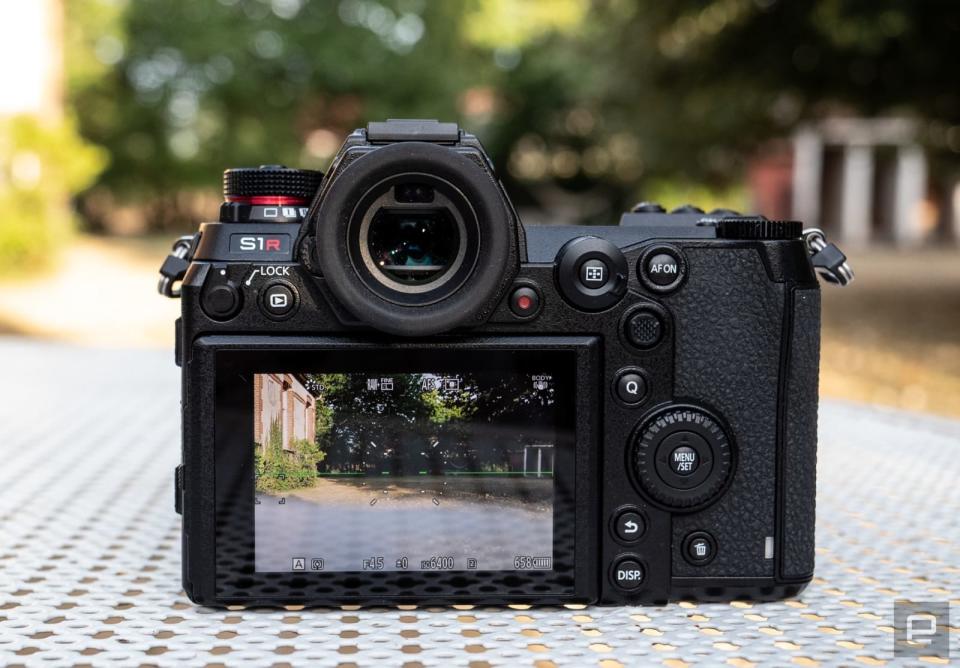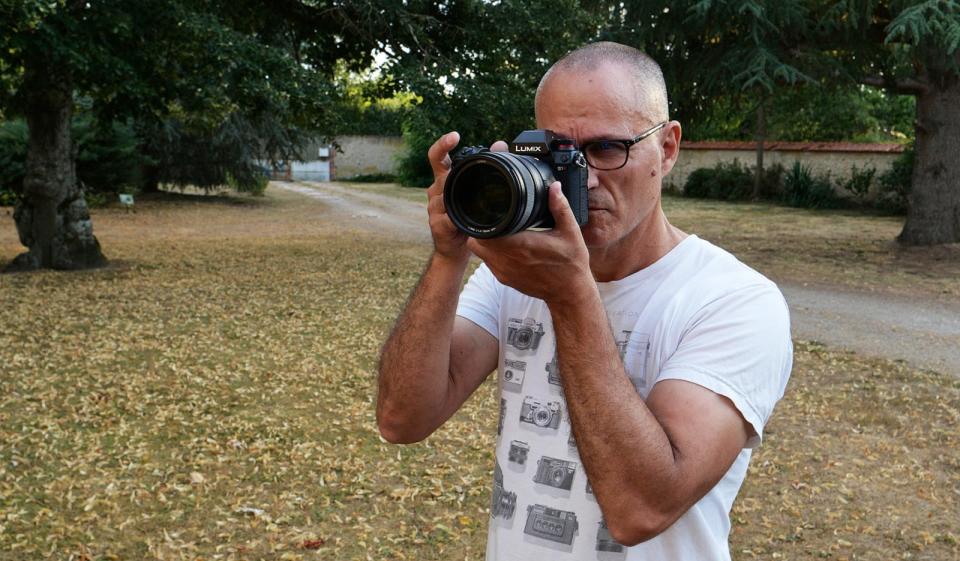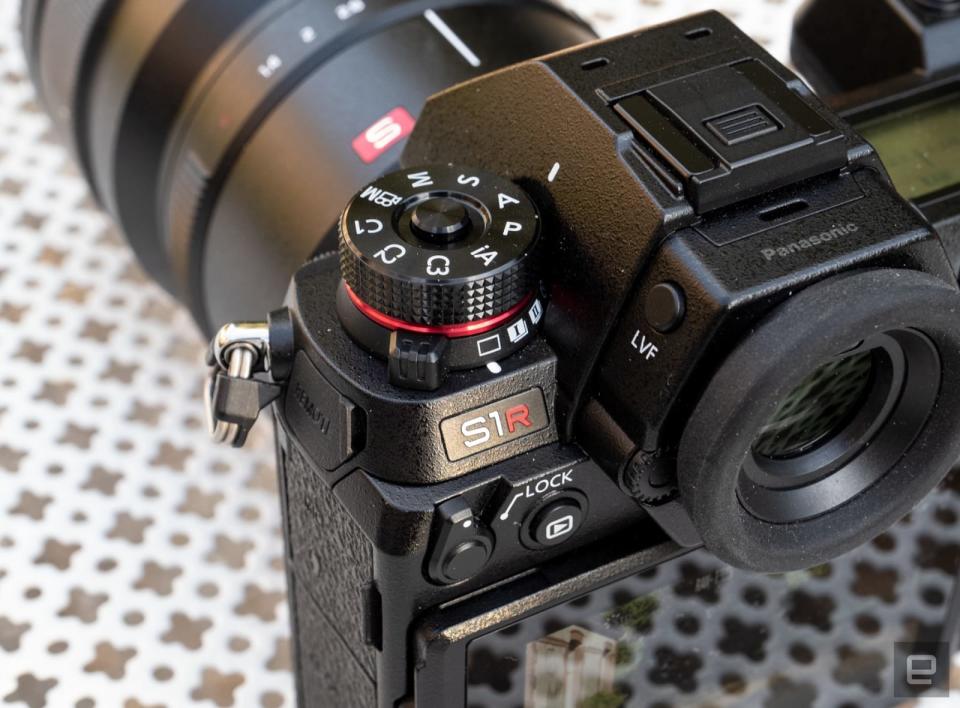Panasonic S1R review: Big, powerful and too expensive
And thanks to Sony, the timing couldn't be worse.
In a brutal camera market, only the strong survive. Until recently, Panasonic has not just survived, but thrived by focusing on niche, video-centric mirrorless cameras like the GH5. With the S1 and S1R models, though, it's going head-on with rivals Nikon, Canon and Sony in the more competitive, and potentially lucrative, full-frame mirrorless market.
I've already looked at the 24.2-megapixel S1. It's a strong rival to Nikon's Z 6 and the Sony A7 III, largely based on the strength of -- you guessed it -- video. Now, I'm reviewing the 47.2-megapixel, $3,700 S1R, and this is where things get more complicated for Panasonic.
It's a lot more expensive than rival models from Nikon and Sony, and can't fall back on video, which isn't important to this market. Rather, it has to rely on features it's not particularly noted for, like high resolution images and autofocus. Unfortunately, Sony just dropped a huge bomb on Panasonic in the form of the full-frame A7R IV, a camera that beats the S1R handily, at least on paper, for less money. To add insult to injury, Sony significantly lowered the price of its previous A7R III model. To find out if the S1R is good enough to survive all this, read on.
Body and handling
Like the S1, the S1R's calling card is its size and ruggedness. It weighs 1,020 grams, or about 2.2 pounds with a battery and memory card -- around 350 grams (0.8 pounds!) more than Sony's A7R IV. While the extra weight is a drawback when lugging the camera around, I appreciated the build quality and excellent handling that came with the large body.
The grip on the S1R is huge, bigger than on any other mirrorless camera, by far. That gave me confidence I'd never drop it, even in slippery or cold conditions. It's also weather-sealed and certified to operate in temperatures from 14 to 104 degrees F, and I shot a lot of photos at around the latter temperature during a heatwave in Paris. While it certainly got hot, it never stopped working.
With the extra size, Panasonic was able to squeeze in tons of manual controls and I found pretty much everything, like the joystick, dials and ISO controls, to be in just the right place. I liked the fact that the focus and shooting controls were on dedicated buttons, rather than buried in menus. The only thing I didn't care for was the placement and operation of the on/off switch, as it's too hard to find by feel and too easy to accidentally bump.
The rear display can be tilted and flipped out, but unfortunately, it can't be flipped around 180 degrees. Considering that the GH5/GH5s has a fully articulating screen, I frankly don't see why the S1/S1R can't have one, too. Even though it's obviously not a vlogging camera (too heavy), it would still be a handy feature for solo videographers like myself.
On the plus side, that screen is touch-enabled, letting you select focus, Q-menu and main menu settings without buttons. I found Panasonic's menus to be very logically grouped into categories and subcategories. Everything is also fully programmable, letting you tweak the camera to work just the way you want.

Panasonic's electronic viewfinder (EVF) is superb, with excellent optics, a 5.76-million dot OLED display, 120 fps refresh rate and .005-seconds of lag. It's sharp and accurate, which let me see quickly if focus and color temperatures were on point. This EVF (also found on Sony's new A7R IV) pretty much destroys any remaining arguments for an optical viewfinder.
The big body houses Panasonic's excellent 5-axis stabilization system. It delivers 6 stops of shake reduction, or 6.5 with dual IS if you have a supported, optically stabilized lens like the Lumix 24-105mm f/4.0 model. It yielded sharp photos down to an 1/8th of a second or less and video that was smooth when shot handheld, as long as I didn't do anything too crazy, like a handheld tracking shot.
Panasonic beats Nikon's Z 7 and the Canon EOS R with two card slots, one for SD UHS II and the other XQD. Working photographers can shoot to both cards at once for backup, and the fast, 440 MB/s XQD slots will be a boon for video shooters. Eventually, the S1R will support CFexpress cards, which will let you transfer media to your PC at up to 1,700 MB/s and save serious amounts of time.
Like the S1, the S1R has both headphone and microphone ports and will support professional XLR audio input/output via a dedicated hotshoe adapter. It's got a USB Type C port for data transfers and charging, a full-sized HDMI port and support for Bluetooth/WiFi transfers and camera control. Camera apps generally suck, but the Lumix Sync app is actually pretty responsive and easy to setup and use.
Performance
Bucking the trend to hybrid phase- and contrast-detect autofocus, Panasonic has stuck with its advanced contrast-detect system that it calls "depth from defocus." The idea is to maximize image quality by eliminating phase-detect pixels on the sensor, while still delivering consistent autofocus performance.
I was less than impressed with the contrast-detect AF on the S1, which tended to hunt or not lock on focus, particularly in low light and during burst and video shooting. The S1R seemed to perform better, however, possibly due to a recent firmware update.

Unlike phase-detect systems, which can lock onto focus directly, the S1R needs to hunt for focus (see an explanation here), which is distracting when you're looking through the EVF. Luckily, I did get sharp images most of the time, even during continuous shooting, when using area, subject and tracking spot autofocus. The hit rate was lower in low-light conditions, but not unmanageably so.
The contrast detect AF is a plus for AI-powered face- and eye-detect AF systems, which don't use phase-detect pixels. I found the S1R's subject, face and eye-tracking systems fast and powerful, keeping my eyes, body and face locked under most circumstances. It also has an animal-detect system that tracked our dogs just fine, but was more confused by the chickens.
Panasonic has done amazing things with depth from defocus, but it's still not as good as hybrid systems, particularly on Sony's A7 cameras. It didn't hit focus as consistently as the A7R III, particularly in burst shooting with continuous autofocus enabled. That said, the S1R is aimed at landscape, architectural and portrait photographers, and for those folks, the AF system is just fine.
With a new firmware release, Panasonic has boosted the stabilization system (IS) from 5.5 to 6 stops, or 6.5 stops with dual IS enabled. I found it worked extremely well, yielding sharp pictures at low shutter speeds, even after I drank several cups of coffee. Tellingly, I shot a number of photos in low-light, and some of the people in the shot were sharp while others (who moved) were blurred. That means the IS system did its job.
The S1R has a big 23Wh battery, but the big sensor, high-res EVF and image stabilization system take their toll. The S1R delivers just 380 shots per charge, compared to 530 for Sony's A7R III and A7R IV. On the plus side, I was able to shoot video for about two hours before changing the battery, which is excellent for a full-frame camera.
Image quality
The S1R's main selling point is the 47.2-megapixel sensor and resulting crisp, color-accurate images. It mostly delivers on that promise, but I did have a few issues.
Naturally, with all that resolution, I got sharp, detailed images giving me lots of room to punch in or crop. If that's not enough, you can use Panasonic's excellent, easy-to-use multi-shot mode that melds four images into a goliath 187-megapixel shot.
With no phase-detect pixels on the sensor, you're never going to get the banding you occasionally see on Sony, Nikon and Canon cameras -- particularly in low-light or backlit situation. That could be a big deal for landscape or architectural photographers who need very clean, high-resolution images.
Color accuracy and skin tones in particular were excellent on the S1R, I found, which is critical for its portrait photographer buyers. That applied to both JPEG and RAW images.
Where it does fall down a bit though is in low-light shooting. While the S1R has a similar ISO range to Sony's A7R III (100 to 25,600, expandable to ISO 50 to 51,200), the sensor doesn't use the same backside illuminated tech. Rather, it has a "waveguide" system to boost light. When I shot at night, it delivered noisier images than the A7R III at the same high ISO settings, particularly when I tried to boost the exposure in post.

On top of that, the S1R has lower dynamic range than its main rivals, the A7R III and Nikon Z 7. As such, I had more trouble recovering RAW image details in highlights and shadows, particularly with high-ISO images.
Still, if you understand the limitations and strengths of the S1R, you're going to get incredible images out of it, particularly with Panasonic's superb Lumix-S 50mm f/1.4 lens.
Video
Video is not the selling point of this camera, but Panasonic has actually done a pretty good job with it. Unlike the S1, the S1R can't read the entire sensor to output 4K video and has to either line-skip (with small 1.1x crop) or crop to APS-C. It can't output 10-bit video, either externally or internally, and lacks the S1's (optional) V-log mode, giving you fewer options in post-production. If you need those things, just get the S1, which is much cheaper anyway.
On the plus side, it can output 4K 60 fps video and shoot 180fps HD. That handily beats Sony's A7R III and A7R IV, and also tops Nikon's Z 7. The image stabilization system works well for video, though I found it to be jerky when I tried to move the camera too quickly. While the S1R has more rolling shutter than the S1, it has much, much less than Sony's A7R III.
I was pretty happy with the rich, sharp 4K video I shot on the S1R, and didn't notice a lot of aliasing unless the subject had a lot of sharp, straight lines. I was equally happy with the slow-motion 180 fps video, though bear in mind that the AF system doesn't work at that speed -- you'll have to rely on manual focus instead. The S1R is pretty good for video in low-light conditions, though less so than the cheaper S1 or Sony's A7 III.
Wrap-up

Things change so quickly that it's impossible to evaluate cameras without considering the big picture. Even just a month ago, I would have had a more positive view of the S1R. After all, it has a great new mount, excellent handling and build quality, snappy performance, good image quality and great video capability for its category. Back then, it would have been an easy camera to recommend for portrait or landscape photographers.
In just the last two weeks, though, things have changed drastically. Sony unveiled the A7R IV, a much higher-resolution 61-megapixel camera that's $200 cheaper than the S1R. At the same time, it lowered the price of the A7R III from $3,000 to $2,500, making it $1,200 cheaper than the $3,700 S1R.
The latter is a cruel, killing blow. Given Sony's price drop, which seems to be permanent, there's no way I can recommend Panasonic's S1R over the A7R III. The latter is just as good as or better than the S1R in most areas, with the exception being slightly inferior resolution and video capability. Sorry, but that's not worth $1,200.
And pending my review, the A7R IV looks like a drastically better offering for the resolution-centric photography market, particularly given the $200 cheaper price. I can't really recommend the S1R over the Nikon Z 7 either, as both cameras perform nearly equally, with a slight edge to the S1R. However, Nikon has dropped the Z 7's price to $3,000, making it $700 cheaper than the S1R.
To be fair, Sony just made things tough for Nikon and Canon, too. Given how Sony is beating it up, Panasonic will need to revisit the S1R's price, which is not competitive. In the meantime, if you really need the S1R's ruggedness, excellent handling and video capability, then it's worth a look. Otherwise, spend a lot less on Sony's A7R III or wait for the higher-resolution A7R IV.
